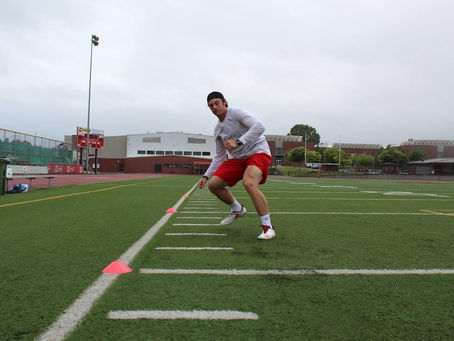top of page


The Truth About Ice Baths, Compression, and Recovery Tools for Youth
"In youth sports, recovery is essential—but flashy tools like ice baths, compression boots, and massage guns are secondary to the basics. For young athletes, the real keys to recovering faster and performing better are quality sleep, proper nutrition, hydration, and smart training loads.

Nation Training
Sep 25


Fueling Young Athletes: The Science Behind Pre- and Post-Workout Meals
"Pre- and post-workout nutrition is one of the most important—and often overlooked—aspects of youth athletic performance. Eating the right foods at the right times fuels energy, supports recovery, and helps young athletes grow stronger, perform better, and reduce the risk of injury.

Nation Training
Sep 23


John 1:1-18
John 1:1-18

Nation Training
Sep 21


The Role of Eccentric Training in Injury Reduction and Performance
Eccentric strength—the ability to control and absorb force as muscles lengthen—is a key ingredient in athletic performance and injury prevention. For young athletes, incorporating controlled lowering movements and deceleration drills builds resilient, high-performing bodies while reducing the risk of common injuries like hamstring strains and ACL tears.

Nation Training
Sep 20


The Recovery Gap in Youth Sports: Why Sleep and Nutrition Matter More Than Supplements
Recovery is the often-overlooked cornerstone of youth athletic performance. For young athletes, quality sleep and proper nutrition—not supplements or gimmicks—are what truly allow the body to adapt, grow stronger, and stay healthy. Before adding extra workouts or recovery products, ask the simple question: is this athlete actually recovering?

Nation Training
Sep 18


Why Strength Comes First: Foundational Training for All Young Athletes
While speed, agility, and sport-specific skills often take the spotlight, the true foundation of athletic performance is strength. For young athletes, building strength safely and progressively improves movement, boosts neuromuscular control, reduces injury risk, and sets the stage for long-term success both on and off the field.

Nation Training
Sep 16


Psalm 19
Psalm 19

Nation Training
Aug 31


Body Fat Percentage in Athletes: What’s Healthy, What’s Optimal, and Why It Matters
Body fat percentage tells a much clearer story than the scale ever will—especially for athletes. In this blog, we break down what healthy and optimal ranges look like, how different sports demand different physiques, and why chasing ultra-low numbers can sometimes do more harm than good. Whether you're trying to gain an edge or just better understand your body, this one's worth the read.

Nation Training
Aug 29


Agility vs Change of Direction Training: What’s the Difference and Why It Matters
Agility and Change of Direction aren't the same—and if you're only training one, you're leaving performance on the table. In this post, we break down the key differences between COD and true agility, why both matter for athletes, and how to train them effectively. If you want to move better, react faster, and play at a higher level, this is a must-read.

Nation Training
Aug 27


Hydration and Electrolytes: The Dynamic Duo for Peak Athletic Performance
Hydration is more than just drinking water—it's about replacing the electrolytes your body loses in sweat to keep performing at your best. Whether you're sprinting, lifting, or grinding through a tough game, understanding how to fuel your body with the right balance of fluids and minerals can be the difference between hitting your peak or crashing early. Check out our latest blog to learn what electrolytes really do and how to hydrate like an athlete.

Nation Training
Aug 25


Psalm 1
Psalm 1

Nation Training
Aug 24


Front Squat vs Back Squat: Which One is Right for You?
Wondering whether the front squat or back squat is better for your training? Both have unique benefits, from building quad strength and core stability to maximizing overall power. Learn which squat fits your goals and sport in our latest blog.

Nation Training
Aug 22


Training Conditioning Based on the Energy Systems Your Sport Demands
Not all conditioning is created equal. Training the right energy system for your sport—whether it’s explosive bursts for football or sustained endurance for distance running—makes all the difference in performance and recovery. Learn how to train smarter, not harder, in our latest blog.

Nation Training
Aug 20


Velocity-Based Training: Why We Use It and How It Elevates Athletic Performance
Want to train smarter, not just harder? Velocity-Based Training with the OVR Velocity Box lets us track bar speed in real time — helping athletes build power, speed, and explosiveness more efficiently than ever.

Nation Training
Aug 18


Psalm 22
Psalm 22

Nation Training
Aug 17


In-Season Training for Football Players: Why It Matters More Than You Think
Skipping the weight room during football season? You could be missing out on over a year’s worth of progress. In-season training isn’t just about staying strong — it’s about building a long-term edge in performance, injury prevention, and development. Find out how just 1–2 sessions a week can make all the difference over a four-year career.

Nation Training
Aug 15


What Does Creatine Do — and Should Athletes Use It?
Confused about creatine? You're not alone. We just dropped a blog post breaking down what it is, what it does, and how young athletes can use it safely to support strength, power, and performance. Backed by science — explained simply.

Nation Training
Aug 13


Unlocking Explosive Performance: What is Post-Activation Potentiation (PAP)?
Want to jump higher, sprint faster, or throw harder — instantly? Post-Activation Potentiation (PAP) is a proven training method that primes your nervous system for explosive performance. We break it down in our newest blog post and show you how we use it in real athlete training.

Nation Training
Aug 11


Psalm 23
Psalm 23

Nation Training
Aug 10


Rotational Power: The Secret Weapon for Baseball and Softball Players
Rotational power is the engine behind every hard hit and high-velocity throw — and it doesn’t come from just lifting heavy. In our latest blog post, we break down why rotational training matters for baseball and softball players, and how to actually build it.

Nation Training
Aug 9
bottom of page
.png)